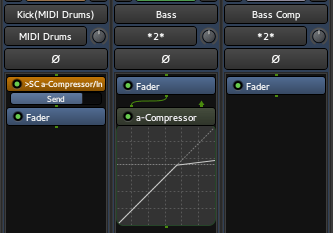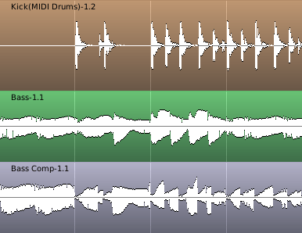
Sidechaining
Dynamic Processors—such as compressors—in general use the the original input signal for analysis and operate on the same signal. Side-chaining uses the signal level of another input to control the compression level of the original signal.
Effect Processors which have a side-chain input (sometimes also called key input) have an additional input pin to receive a signal from an external input. In Ardour that extra input can be connected in the plugin's Pin Configuration dialog: the signal from one track can be tapped off and used as an input to a plugin on a different track. This dialog is accessed via the plugin's context-menu > Pin Connections….
In case a plugin has a dedicated sidechain input, Ardour automatically creates a port for the input. This is a normal I/O port which can be fed by any external signal. The Pin Configuration dialog is not limited to processors with a dedicated sidechain input, it also allows to manually create (or remove) a sidechain input port and provides for flexible connection of the signal to plugin pins.
The operational flow in the Ardour GUI starts at the processor which is to receive the signal: a sidechain source is selected, and Ardour creates a dedicated send-processor in the source processor box, the level of which can be adjusted either in the Pin Configuration window or directly on the source's send.
A simple example: Sidechain compression
One example is the use of a bassdrum track to trigger the compression on a bass track. The sidechain compressor (a-Compressor) will be placed on the bass track, and will need to receive the signal from the bassdrum track as a way to trigger the compression.



Here, on the bass track, an a-Compressor has been added, and the Drum track has been set as the sidechain source. The mixer reflects this by showing an SC-send processor in the drum track, very similar to a send. The bass track also shows an arrow as one of the a-compressor input.
As a result, in the editor, each peak in the kick drum track triggers the compression on the bass track and the resulting track shows the compression kicking in on each kick drum peak, hence reducing the gain. The compression is applied to the bass, but only based on the level of the drum track.
This is commonly used for ducking effect, when e.g. a radio speaker's voice triggers the compression on the audio playing.
MIDI Sidechaining
Ardour allows the sidechain sources to be either audio or MIDI tracks/busses. This is particularly useful when a MIDI signal is used to control an audio effect, like a vocoder or an auto-tuner, like fat1, the LV2 port of Fons Adriaensen's Zita AT1 by Robin Gareus:

Here, the MIDI track is inputed to the plugin's MIDI IN pin through a sidechain, indicating to the plugin what note should the source audio be corrected to.
Notice that in the example above, the output of the "Vocals" track is connected to the input of the "Corrected" track. We could have chosen to insert the "Vocals" track content as an audio sidechain too, totally disconnecting the input from the plugin, and connecting the plugin's input pin to the audio sidechain port.
Pre-processing the sidechained signal
Sometimes, the effects of a sidechain signal on a plugin can be enhanced by pre-processing the signal.
In the first example above, if the entire drum part is on one track, then compressing with this signal as a sidechain will result in every peak triggering the compression, be them bass drum kicks or snare, cymbals, etc.
In this case, adding an EQ to the drum track with a low pass filter would filter out the peaks created by the high pitched instruments of the drum kit, and allow for a better triggering, though to avoid damaging the original drum track, a send to an intermediary track would be better suited to place the EQ on. This track won't be connected to the Master, as its content is of no musical interest except for it's use as a trigger, allowing for some extreme EQ.
